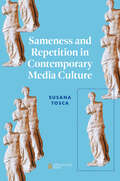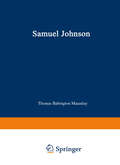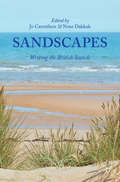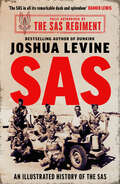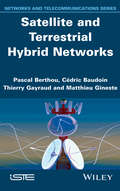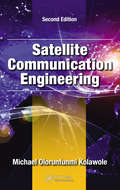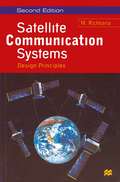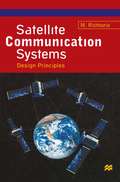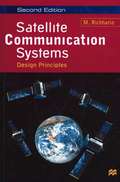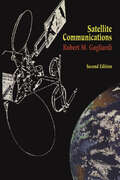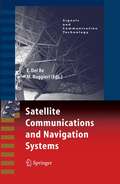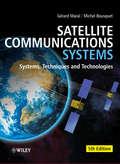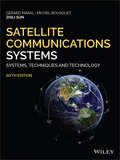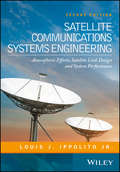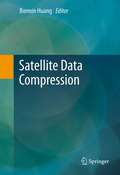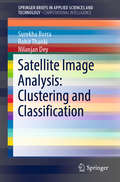- Table View
- List View
Sameness and Repetition in Contemporary Media Culture
by Susana ToscaThe ebook edition of this title is Open Access and freely available to read online. Our culture has an uneasy relationship with repetition and sameness. On the one hand, we find familiarity pleasurable and soothing; on the other, we crave novelty and long for a sense of discovery. We blame algorithms, intent on selling us more of the same, and on a media industry too greedy to risk investing in intellectually challenging, radically new, products. Sameness and Repetition in Contemporary Media Culture takes a comprehensive approach that both theorises and historically grounds the idea of repetition in relation to media as something that is deeply embedded in our cultural tradition. This project received funding from the Carlsberg Foundation.
Sampling Techniques for Supervised or Unsupervised Tasks (Unsupervised and Semi-Supervised Learning)
by Frédéric Ros Serge GuillaumeThis book describes in detail sampling techniques that can be used for unsupervised and supervised cases, with a focus on sampling techniques for machine learning algorithms. It covers theory and models of sampling methods for managing scalability and the “curse of dimensionality”, their implementations, evaluations, and applications. A large part of the book is dedicated to database comprising standard feature vectors, and a special section is reserved to the handling of more complex objects and dynamic scenarios. The book is ideal for anyone teaching or learning pattern recognition and interesting teaching or learning pattern recognition and is interested in the big data challenge. It provides an accessible introduction to the field and discusses the state of the art concerning sampling techniques for supervised and unsupervised task.Provides a comprehensive description of sampling techniques for unsupervised and supervised tasks;Describe implementation and evaluation of algorithms that simultaneously manage scalable problems and curse of dimensionality;Addresses the role of sampling in dynamic scenarios, sampling when dealing with complex objects, and new challenges arising from big data. "This book represents a timely collection of state-of-the art research of sampling techniques, suitable for anyone who wants to become more familiar with these helpful techniques for tackling the big data challenge."M. Emre Celebi, Ph.D., Professor and Chair, Department of Computer Science, University of Central Arkansas"In science the difficulty is not to have ideas, but it is to make them work" From Carlo Rovelli
Samson and Delilah in Medieval Insular French: Translation and Adaptation (The New Middle Ages)
by Catherine LégluSamson and Delilah in Medieval Insular French investigates several different adaptations of the story of Samson that enabled it to move from a strictly religious sphere into vernacular and secular artworks. Catherine Léglu explores the narrative’s translation into French in medieval England, examining the multiple versions of the Samson narrative via its many adaptations into verse, prose, visual art and musical. Utilizing a multidisciplinary approach, this text draws together examples from several genres and media, focusing on the importance of book learning to secular works. In analysing this Biblical narrative, Léglu reveals the importance of the Samson and Delilah story as a point of entry into a fuller understanding of medieval translations and adaptations of the Bible.
Samson and Delilah in Medieval Insular French: Translation and Adaptation (The New Middle Ages)
by Catherine LégluSamson and Delilah in Medieval Insular French investigates several different adaptations of the story of Samson that enabled it to move from a strictly religious sphere into vernacular and secular artworks. Catherine Léglu explores the narrative’s translation into French in medieval England, examining the multiple versions of the Samson narrative via its many adaptations into verse, prose, visual art and musical. Utilizing a multidisciplinary approach, this text draws together examples from several genres and media, focusing on the importance of book learning to secular works. In analysing this Biblical narrative, Léglu reveals the importance of the Samson and Delilah story as a point of entry into a fuller understanding of medieval translations and adaptations of the Bible.
Sandscapes: Writing the British Seaside
by Jo Carruthers Nour DakkakSandscapes: Writing the British Seaside reflects on the unique topography of sand, sandscapes, and the seaside in British culture and beyond. This book brings together creative and critical writings that explore the ways sand speaks to us of holidays and respite, but also of time and mortality, of plenitude and eternity. Drawing together writers from a range of backgrounds, the volume explores the environmental, social, personal, cultural, and political significance of sand and the seaside towns that have built up around it. The contributions take a variety of forms including fiction and nonfiction and cover topics ranging from sand dunes to sand mining, from seaside stories to shoreline architecture, from sand grains to global sand movements, from narratives of the setting up of bed and breakfasts to stories of seaside decline. Often a symbol of aridity, sand is revealed in this book to be an astonishingly fertile site for cultural meaning.
SAP BusinessObjects Dashboards 4.1 Cookbook
by David Lai Xavier HackingIf you are a developer with a good command and knowledge of creating dashboards, but are not yet an advanced user of SAP BusinessObjects Dashboards, then this is the perfect book for you. Prerequisites include a good working knowledge of Microsoft Excel as well as knowledge of basic dashboard practices.
SAS: The Illustrated History Of The Sas
by Joshua LevineThe authorised illustrated history of the SAS by the number one bestselling author of Dunkirk, Joshua Levine. With never-before-seen photographs and unheard stories, this is the SAS’s wartime history in vivid and astonishing detail.
Satellite and Terrestrial Hybrid Networks
by Pascal Berthou Cédric Baudoin Thierry Gayraud Matthieu GinesteThis book offers the reader the keys for a successful understanding, integration and usage of satellite systems in addition to next generation terrestrial networks. The DVB-S2/RCS system is used to illustrate the integration challenges. The presentation uses a system approach, i.e. it tackles the terrestrial and satellite telecommunication systems’ complexity with a high level approach, focusing on the systems’ components and on their interactions. Several scenarios present the different paths that can be followed for the integration of satellite systems in terrestrial networks. Quality of Service management techniques in terrestrial and satellite systems and the solutions to help them to interoperate are provided. Inter-system mobility solutions and performance problems are then addressed. The solutions proposed in this book have been developed within the framework of European and French funded research projects and tested with simulated or real testbeds.
Satellite and Terrestrial Hybrid Networks
by Pascal Berthou Cédric Baudoin Thierry Gayraud Matthieu GinesteThis book offers the reader the keys for a successful understanding, integration and usage of satellite systems in addition to next generation terrestrial networks. The DVB-S2/RCS system is used to illustrate the integration challenges. The presentation uses a system approach, i.e. it tackles the terrestrial and satellite telecommunication systems’ complexity with a high level approach, focusing on the systems’ components and on their interactions. Several scenarios present the different paths that can be followed for the integration of satellite systems in terrestrial networks. Quality of Service management techniques in terrestrial and satellite systems and the solutions to help them to interoperate are provided. Inter-system mobility solutions and performance problems are then addressed. The solutions proposed in this book have been developed within the framework of European and French funded research projects and tested with simulated or real testbeds.
Satellite Communication Engineering
by Michael Olorunfunmi KolawoleAn undeniably rich and thorough guide to satellite communication engineering, Satellite Communication Engineering, Second Edition presents the fundamentals of information communications systems in a simple and succinct way. This book considers both the engineering aspects of satellite systems as well as the practical issues in the broad field of information transmission. Implementing concepts developed on an intuitive, physical basis and utilizing a combination of applications and performance curves, this book starts off with a progressive foundation in satellite technology, and then moves on to more complex concepts with ease. What’s New in the Second Edition: The second edition covers satellite and Earth station design; global positioning systems; antenna tracking; links and communications systems; error detection and correction; data security; regulations and procedures for system modeling; integration; testing; and reliability and performance evaluation. Provides readers with the systems building blocks of satellite transponders and Earth stations, as well as the systems engineering design procedure Includes the tools needed to calculate basic orbit characteristics such as period, dwell time, coverage area, propagation losses; antenna system features such as size, beamwidth, aperture-frequency product, gain, tracking control; and system requirements such as power, availability, reliability, and performance Presents problem sets and starred sections containing basic mathematical development Details recent developments enabling digital information transmission and delivery via satellite Satellite Communication Engineering, Second Edition serves as a textbook for students and a resource for space agencies and relevant industries.
Satellite Communication Engineering
by Michael Olorunfunmi KolawoleAn undeniably rich and thorough guide to satellite communication engineering, Satellite Communication Engineering, Second Edition presents the fundamentals of information communications systems in a simple and succinct way. This book considers both the engineering aspects of satellite systems as well as the practical issues in the broad field of information transmission. Implementing concepts developed on an intuitive, physical basis and utilizing a combination of applications and performance curves, this book starts off with a progressive foundation in satellite technology, and then moves on to more complex concepts with ease. What’s New in the Second Edition: The second edition covers satellite and Earth station design; global positioning systems; antenna tracking; links and communications systems; error detection and correction; data security; regulations and procedures for system modeling; integration; testing; and reliability and performance evaluation. Provides readers with the systems building blocks of satellite transponders and Earth stations, as well as the systems engineering design procedure Includes the tools needed to calculate basic orbit characteristics such as period, dwell time, coverage area, propagation losses; antenna system features such as size, beamwidth, aperture-frequency product, gain, tracking control; and system requirements such as power, availability, reliability, and performance Presents problem sets and starred sections containing basic mathematical development Details recent developments enabling digital information transmission and delivery via satellite Satellite Communication Engineering, Second Edition serves as a textbook for students and a resource for space agencies and relevant industries.
Satellite Communication Systems: Design Principles
by Madhavendra RichhariaThis state-of-the art guide offers an in-depth treatment of the elements and components that comprise satellite communication systems. The book takes the reader step-by-step through the principles and methods of system design - all in easy-to-understand language avoiding long mathematical derivations.
Satellite Communication Systems (PDF)
by M. RichhariaThis state-of-the art guide offers an in-depth treatment of the elements and components that comprise satellite communication systems. The book takes the reader step-by-step through the principles and methods of system design - all in easy-to-understand language avoiding long mathematical derivations.
Satellite Communications
by Robert M. GagliardiThis second edition of Satellite Communications is a revised, updated, and improved version of the first edition (Van Nostrand, 1984) and has been extended to include many newer topics that are rapidly becoming important in modem and next-generation satellite systems. The first half of the book again covers the basics of satellite links, but has been updated to include additional areas such as Global Positioning and deep space satellites, dual polarization, multiple beaming, advanced satellite electronics, frequency synthesizers, and digital frequency generators. The second half of the book is all new, covering frequency and beam hopping, on-board processing, EHF and optical cross links, and mobile satellites and VSAT systems. All of these latter topics figure to be important aspects of satellite systems and space platforms of the twenty-first century. As in the first edition, the objective of the new edition is to present a unified approach to satellite communications, helping the reader to become familiar with the terminology, models, analysis procedures, and evolving design directions for modem and future satellites. The presentation stresses overall system analysis and block diagram design, as opposed to complicated mathematical or physics descriptions. (Backup mathematics is relegated to the appendices where a reader can digest the detail at his own pace. ) The discussion begins with the simplest satellite systems and builds to the more complex payloads presently being used.
Satellite Communications and Navigation Systems (Signals and Communication Technology)
by Enrico Re Marina RuggieriSatellite Communications and Navigation Systems publishes the proceedings of the 2006 Tyrrhenian International Workshop on Digital Communications. The book focuses on the integration of communication and navigation systems in satellites.
Satellite Communications Systems: Systems, Techniques and Technology
by Gerard Maral Michel BousquetRevisions to 5th Edition by: Zhili Sun, University of Surrey, UK New and updated edition of this authoritative and comprehensive reference to the field of satellite communications engineering Building on the success of previous editions, Satellite Communications Systems, Fifth Edition covers the entire field of satellite communications engineering from orbital mechanics to satellite design and launch, configuration and installation of earth stations, including the implementation of communications links and the set-up of the satellite network. This book provides a comprehensive treatment of satellite communications systems engineering and discusses the technological applications. It demonstrates how system components interact and details the relationship between the system and its environment. The authors discuss the systems aspects such as techniques enabling equipment and system dimensioning and state of the art technology for satellite platforms, payloads and earth stations. New features and updates for the fifth edition include: More information on techniques allowing service provision of multimedia content Extra material on techniques for broadcasting, including recent standards DVB-RCS and DVB-S2 (Digital Video Broadcasting -Return Channel Satellite and -Satellite Version 2) Updates on onboard processing By offering a detailed and practical overview, Satellite Communications Systems continues to be an authoritative text for advanced students, engineers and designers throughout the field of satellite communications and engineering.
Satellite Communications Systems: Systems, Techniques and Technology
by Gerard Maral Michel BousquetRevisions to 5th Edition by: Zhili Sun, University of Surrey, UK New and updated edition of this authoritative and comprehensive reference to the field of satellite communications engineering Building on the success of previous editions, Satellite Communications Systems, Fifth Edition covers the entire field of satellite communications engineering from orbital mechanics to satellite design and launch, configuration and installation of earth stations, including the implementation of communications links and the set-up of the satellite network. This book provides a comprehensive treatment of satellite communications systems engineering and discusses the technological applications. It demonstrates how system components interact and details the relationship between the system and its environment. The authors discuss the systems aspects such as techniques enabling equipment and system dimensioning and state of the art technology for satellite platforms, payloads and earth stations. New features and updates for the fifth edition include: More information on techniques allowing service provision of multimedia content Extra material on techniques for broadcasting, including recent standards DVB-RCS and DVB-S2 (Digital Video Broadcasting -Return Channel Satellite and -Satellite Version 2) Updates on onboard processing By offering a detailed and practical overview, Satellite Communications Systems continues to be an authoritative text for advanced students, engineers and designers throughout the field of satellite communications and engineering.
Satellite Communications Systems: Systems, Techniques and Technology
by Gerard Maral Michel Bousquet Zhili SunThe revised and updated sixth edition of Satellite Communications Systems contains information on the most recent advances related to satellite communications systems, technologies, network architectures and new requirements of services and applications. The authors – noted experts on the topic – cover the state-of-the-art satellite communication systems and technologies and examine the relevant topics concerning communication and network technologies, concepts, techniques and algorithms. New to this edition is information on internetworking with the broadband satellite systems, more intensive coverage of Ka band technologies, GEO high throughput satellite (HTS), LEO constellations and the potential to support the current new broadband Internet services as well as future developments for global information infrastructure. The authors offer details on digital communication systems and broadband networks in order to provide high-level researchers and professional engineers an authoritative reference. The companion website provides slides for instructors to teach and for students to learn. In addition, the book is designed in a user-friendly format.
Satellite Communications Systems: Systems, Techniques and Technology
by Gerard Maral Michel Bousquet Zhili SunThe revised and updated sixth edition of Satellite Communications Systems contains information on the most recent advances related to satellite communications systems, technologies, network architectures and new requirements of services and applications. The authors – noted experts on the topic – cover the state-of-the-art satellite communication systems and technologies and examine the relevant topics concerning communication and network technologies, concepts, techniques and algorithms. New to this edition is information on internetworking with the broadband satellite systems, more intensive coverage of Ka band technologies, GEO high throughput satellite (HTS), LEO constellations and the potential to support the current new broadband Internet services as well as future developments for global information infrastructure. The authors offer details on digital communication systems and broadband networks in order to provide high-level researchers and professional engineers an authoritative reference. The companion website provides slides for instructors to teach and for students to learn. In addition, the book is designed in a user-friendly format.
Satellite Communications Systems Engineering: Atmospheric Effects, Satellite Link Design and System Performance (Wireless Communications And Mobile Computing Ser.)
by Louis J. Ippolito Jr.The first edition of Satellite Communications Systems Engineering (Wiley 2008) was written for those concerned with the design and performance of satellite communications systems employed in fixed point to point, broadcasting, mobile, radio navigation, data relay, computer communications, and related satellite based applications. This welcome Second Edition continues the basic premise and enhances the publication with the latest updated information and new technologies developed since the publication of the first edition. The book is based on graduate level satellite communications course material and has served as the primary text for electrical engineering Masters and Doctoral level courses in satellite communications and related areas. Introductory to advanced engineering level students in electrical, communications and wireless network courses, and electrical engineers, communications engineers, systems engineers, and wireless network engineers looking for a refresher will find this essential text invaluable.
Satellite Communications Systems Engineering: Atmospheric Effects, Satellite Link Design and System Performance
by Louis J. Ippolito Jr.The first edition of Satellite Communications Systems Engineering (Wiley 2008) was written for those concerned with the design and performance of satellite communications systems employed in fixed point to point, broadcasting, mobile, radio navigation, data relay, computer communications, and related satellite based applications. This welcome Second Edition continues the basic premise and enhances the publication with the latest updated information and new technologies developed since the publication of the first edition. The book is based on graduate level satellite communications course material and has served as the primary text for electrical engineering Masters and Doctoral level courses in satellite communications and related areas. Introductory to advanced engineering level students in electrical, communications and wireless network courses, and electrical engineers, communications engineers, systems engineers, and wireless network engineers looking for a refresher will find this essential text invaluable.
Satellite Data Compression: 31 July-1 August, 2005, San Diego, California, Usa (Proceedings Of Spie Ser. #5889)
by Bormin HuangSatellite Data Compression covers recent progress in compression techniques for multispectral, hyperspectral and ultra spectral data. A survey of recent advances in the fields of satellite communications, remote sensing and geographical information systems is included. Satellite Data Compression, contributed by leaders in this field, is the first book available on satellite data compression. It covers onboard compression methodology and hardware developments in several space agencies. Case studies are presented on recent advances in satellite data compression techniques via various prediction-based, lookup-table-based, transform-based, clustering-based, and projection-based approaches. This book provides valuable information on state-of-the-art satellite data compression technologies for professionals and students who are interested in this topic. Satellite Data Compression is designed for a professional audience comprised of computer scientists working in satellite communications, sensor system design, remote sensing, data receiving, airborne imaging and geographical information systems (GIS). Advanced-level students and academic researchers will also benefit from this book.
Satellite Image Analysis: Clustering and Classification (SpringerBriefs in Applied Sciences and Technology)
by Surekha Borra Rohit Thanki Nilanjan DeyThanks to recent advances in sensors, communication and satellite technology, data storage, processing and networking capabilities, satellite image acquisition and mining are now on the rise. In turn, satellite images play a vital role in providing essential geographical information. Highly accurate automatic classification and decision support systems can facilitate the efforts of data analysts, reduce human error, and allow the rapid and rigorous analysis of land use and land cover information. Integrating Machine Learning (ML) technology with the human visual psychometric can help meet geologists’ demands for more efficient and higher-quality classification in real time. This book introduces readers to key concepts, methods and models for satellite image analysis; highlights state-of-the-art classification and clustering techniques; discusses recent developments and remaining challenges; and addresses various applications, making it a valuable asset for engineers, data analysts and researchers in the fields of geographic information systems and remote sensing engineering.
